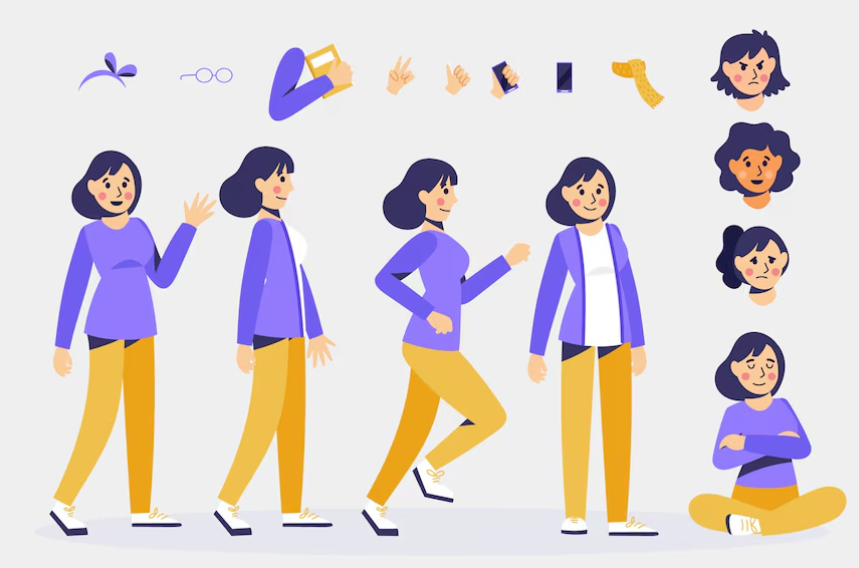Introduction
What is 2D Animation: For decades, animation has been a vital element of visual storytelling, engaging audiences with its dynamic representation of characters and scenarios. Among its various forms, the 2D animation course stands out as one of the most traditional techniques, utilizing a two-dimensional artistic space to create movement.
What is 2D Animation: Although 3D animation has gained prominence, 2D animation remains favored for its distinctive style, accessibility, and affordability. In this article, we will explore what 2D animation entails, detail the steps involved in its creation, and provide a comprehensive guide on how to produce your own 2D animations.
What is 2D Animation?
What is 2D Animation: 2D animation, or two-dimensional animation, refers to the process of creating movement in a flat, two-dimensional space. This technique involves designing characters, backgrounds, and effects on planes with width and height but no depth. It is widely used across various media, such as films, TV shows, video games, and online content. The hallmark of 2D animation is its ability to convey smooth and fluid motion by presenting a rapid sequence of images or frames.
The Process of 2D Animation
Creating 2D animation is a multi-step process, each stage crucial to producing a refined final product. Here is a detailed breakdown:
- Concept and Storyboarding
- Concept Development: Begin by brainstorming and refining the core idea of the animation. Establish a clear vision for the story, characters, and overall theme.
- Storyboarding: Create storyboards to visually map out the scenes of the animation. This serves as a blueprint for planning the sequence of events and visualizing the narrative flow.
- Scriptwriting
- With a solid concept in place, draft a script that includes dialogue, scene descriptions, and other essential details to guide the animation process.
- Character Design and Backgrounds
- Character Design: Develop detailed sketches of the characters, focusing on their appearance, personality, and movements.
- Background Design: Design backgrounds that complement the story’s setting and mood. These can range from simple colors to elaborate, detailed environments.
- Animating
- Keyframes: Create keyframes to define the starting and ending points of significant movements. Keyframes are crucial for mapping out the primary actions of characters and scenes.
- In-betweening: Also known as tweening, this process involves generating the intermediate frames between keyframes to ensure smooth transitions and fluid motion.
- Adding Sound
- Voice Acting: Record the dialogue for your characters, which can be done in a professional studio or with high-quality home recording equipment.
- Sound Effects: Integrate sound effects to enhance the realism and depth of the animation.
- Music: Add background music to set the tone and mood, enriching the overall viewing experience.
- Final Touches and Editing
- After all elements are assembled, the final step is to edit the animation. This includes refining the timing, adding final details, and ensuring the animation flows seamlessly.
How to Make 2D Animation: Step-by-Step Guide
Step 1: Choose Your Tools
Select the animation software you’ll use. Popular options include Adobe Animate, Toon Boom Harmony, and OpenToonz. These tools provide various features for creating and editing 2D animations.
Step 2: Develop a Concept and Storyboard
Start with a clear idea and create a storyboard to outline your animation’s sequence. Sketch key scenes and transitions to visualize the flow.
Step 3: Write the Script
Draft a comprehensive script that details all dialogues, actions, and scene descriptions. This script will guide you throughout the animation process.
Step 4: Design Characters and Backgrounds
Design and refine characters and backgrounds using your chosen software. Ensure they align with the animation’s style and tone.
Step 5: Animate the Keyframes
Begin by animating keyframes, which define the main points of movement in your animation.
Step 6: Tweening
Create the in-between frames that fill the gaps between keyframes. Tweening is essential for creating smooth transitions and fluid motion.
Step 7: Add Sound
Record voice acting, add sound effects, and incorporate background music. Sync these audio elements with the animation to enhance the overall experience.
Step 8: Edit and Finalize
Review the animation, making necessary adjustments. Refine timing, movements, and add final touches to ensure a polished result.
FAQs
1. What software is best for 2D animation? Some of the best software for 2D animation includes Adobe Animate, Toon Boom Harmony, and OpenToonz. These programs offer powerful tools for creating professional-quality animations.
2. How long does it take to create a 2D animation? The time required depends on the project’s complexity and length. Short animations might take a few weeks, while a full-length feature could require several months to years.
3. Do I need to be skilled at drawing to create 2D animations? While strong drawing skills can be helpful, they are not mandatory. Many animation software programs offer tools and resources to aid in creating animations, even if you are not a professional artist.
Conclusion
What is 2D Animation: 2D animation is a classic art form that continues to engage audiences with its unique visual appeal and storytelling capabilities. By following the step-by-step guide provided, you can create your 2D animations and bring your creative ideas to life. Whether for personal enjoyment, professional projects, or creative exploration, What is 2D Animation: 2D animation offers endless opportunities for artistic expression and innovation.


